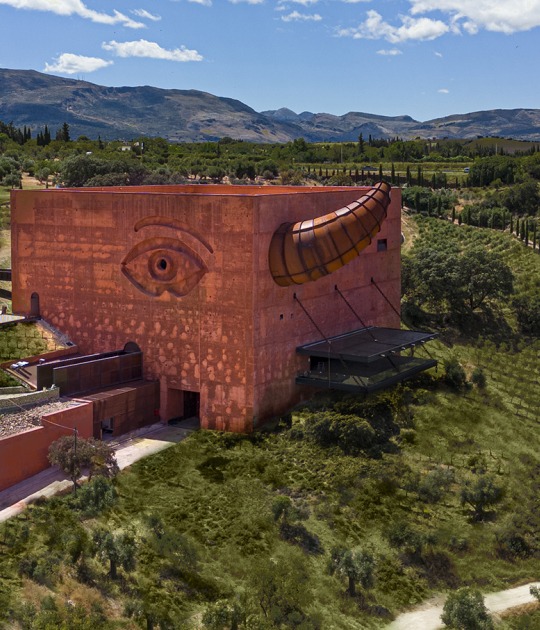The design of 20.000 square feet flagship by David Chipperfield follows the new store concept developed together with Valentino’s Creative Directors, Maria Grazia Chiuri and Pierpaolo Piccioli, in 2012, and already applied to various boutiques around the world.
Located in the former Takashimaya Department store designed by John Burgee and Philip Johnson, the store is fronted by an eight storey façade composed of black steel and aluminium. The monumental atrium, lined in terrazzo, features a prominent monolithic stair.
The 5th Avenute Flagship will carry all product categories: women’s ready-to-wear, accessories, along with a complete men’s collection. The selection of Valentino Garavani accessories will include the new Camubutterfly pieces and Zodiac finger clutches that will be exclusive to Fifth Avenue.The store concept combines old and new in order to generate a Palazzo atmosphere, promoting a new architectural format. An opportunity to offer a one-of-a-kind Valentino experience while catering to an elite clientele in a single bespoke location.
Description of the project by Potiropoulos D+L Architects...
The Valentino New York Flagship Store is situated on Fifth Avenue in the former Takashimaya Department Store, designed by John Burgee and Philip Johnson, which opened in 1993.
The 1,100 square metre flagship store (1,400 square metres including basement) officially opened on 1 August 2014. It continues the new Store Concept developed for Valentino by David Chipperfield Architects in collaboration with the brand’s Creative Directors in 2012. By combining old and new, the Store Concept generates a palazzo- like atmosphere, steering away from a showroom approach of a traditional boutique and promoting a more architectural retail format instead.
Architectural elements are at the heart of the design concept. Architecture is brought into the store rather than remaining on the exterior alone, thereby reducing the use of superficial decoration and thin panels to create an interior scenography. Architectural features such staircases, walls and columns remain exposed to reveal their intrinsic materiality and complement the items on display. This approach imbues the store with a sense of permanence and purity that reflects the quality of the brand’s products.
While the Store Concept has been implemented in numerous locations worldwide, the Fifth Avenue Flagship Store also integrates new developments. The building incorporates a new slim, transparent eight-story façade composed of black steel and aluminium, inspired by some of the city’s modernist icons, such as Mies van der Rohe’s Seagram Building. At the lower part of the façade the vertical bars have a brass finish, while the five upper floors remain black. The brass finish unifies the store front across the three retail levels. Also integrated into the façade system are a lantern, a clock and the Valentino sign – all presented as (brass) elements of the façade.
At the entrance, a double-height space houses a monolithic staircase made of palladiana. This staircase connects all the store levels, taking the customers on an ascending tour and allowing them to observe and experience the striking entrance space from the upper levels. This entrance space is made of terrazzo and features a display wall (8 x 8 metres) in which a series of single shelves exhibit different items. At ground floor level, a completely new Accessories Concept is adopted, with terrazzo perimeter walls on which brass and oak shelves are attached for product display. A new range of timber display furniture sits in conjunction with long marble volumes that act both as plinths and furniture.
The level above follows the traditional Woman Store Concept: an enfilade of rooms, each with different architectural characteristics, separating different types of merchandise. Each space offers a distinct atmosphere generated by a custom palette of colours, textures, and lights. The architecture is designed to complement the pieces on display, making use of a range of materials (grey Venetian terrazzo with Carrara chippings, timber, marble, leather, carpet and carbon fibre) subdued in colour to focus attention on the collections and also evoke a sense of intimacy.
On the top store level, the new Man Store Concept proposes terrazzo walls and palladiana floors. The collection is displayed on oak shelving and hanging elements, which are supported by polished brass fixtures around the perimeter. These features incorporate LED lighting, allowing each shelf or display to be discreetly illuminated. The Man Store Concept offers a consistent experience through unified floor surfaces of terrazzo and palladiana. A series of pure volumes, such as the marble blocks and free standing marble columns, complete the architecture in a similar way to the ground level, where the new Accessories Concept is applied.
The general lighting strategy of the Fifth Avenue Store reflects the variety of spaces and finishes. Overhead lighting combines concealed ambient lighting and clear white product lights on the periphery of the rooms, with warm lighting or decorative chandeliers at the centre.
The new global Store Concept for Man and Woman creates a shared personal atmosphere while still maintaining the brand’s fundamental values of craftsmanship, romanticism and classical style
CREDITS. DATA SHEET.-
Architects.- David Chipperfield Architects.
Location.- Fifth Avenue, New York, USA.
Project start.- 2013.
Completion.- 2014.
Gross floor area.- 1,143.00 m²
Client.- Valentino USA.





































